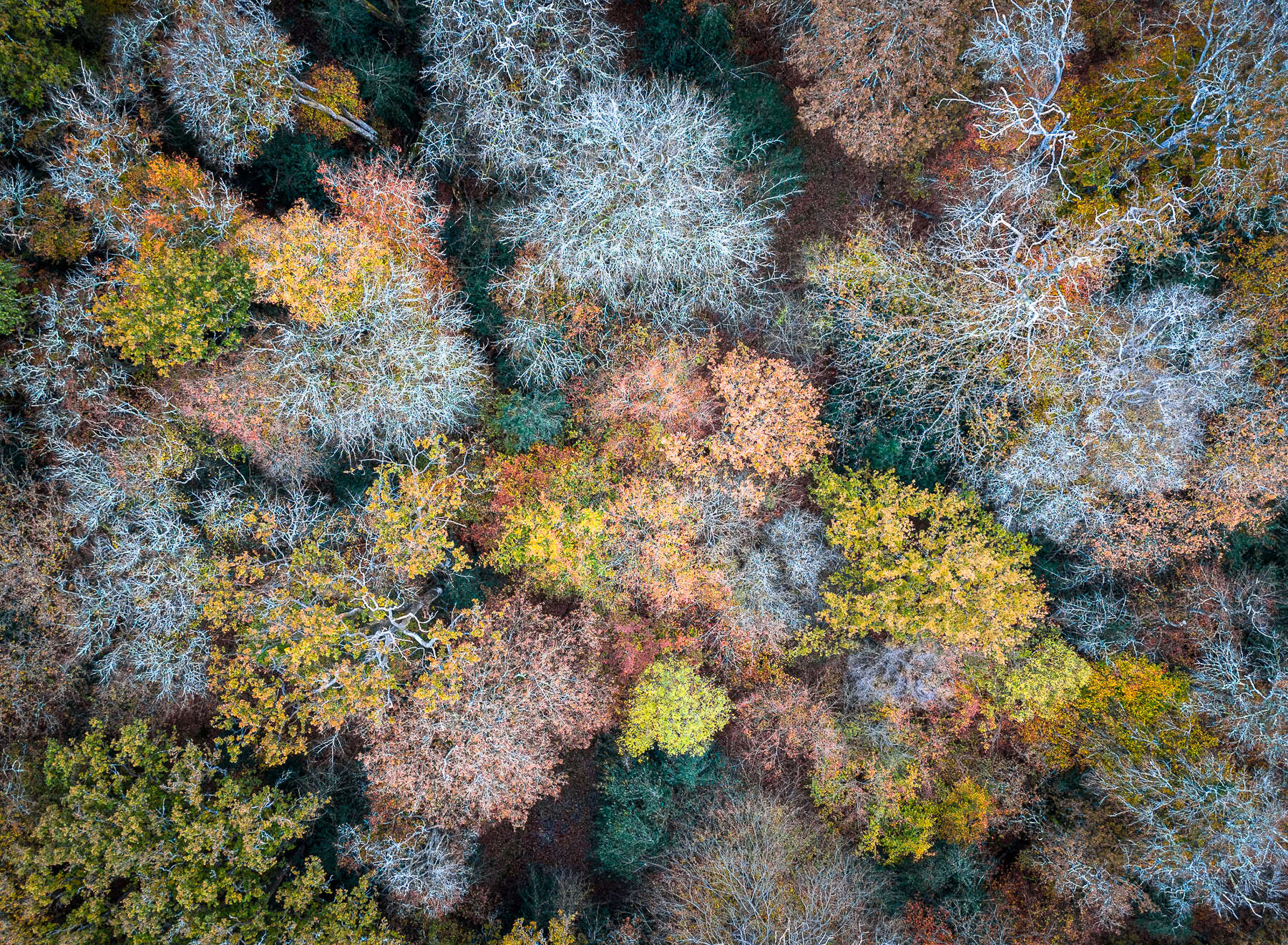Aerial view of autumnal mixed woodland
It's autumn, and as beautiful as the New Forest is, it has to be self-deprecatingly said that it is a more measured, subdued beauty compared to the wide, dramatic vistas of splendour and spectacle you see in photos of New England's fiery fall colours. The timing and intensity of each species' autumnal transformation, a reflection of its unique biochemistry, vary subtly each year depending on location and the year's weather, such that some years, whether in the New Forest or New England, when nature deals a perfect hand of variables, the result can be utterly spectacular.
Typically, the silver birch leaves are among the first to turn their soft yellow before dropping, leaving behind a ghostly tracery of white branches and twigs. The oak, beech, crab apple, blackthorn and hawthorn foliage turn later, progressively layering the landscape in the classic autumnal patchwork of yellows, reds and browns seen in this photo. Through the autumnal blaze, the abundance of evergreens in the forest - holly, ivy, pine, larch and yew - punctuate the warm glow with their cooler, darker tones. In this photo, it's the hollies' dark, glossy green that brings the contrast.
Photographing these scenes from the air is fun and rewarding. Rather than hunting for the perfect framing with the drone, I prefer to take it up to a higher altitude for a wider view, with the 48-megapixel resolution of the camera leaving me the flexibility to crop into the most pleasing composition during the edit. A slight saturation boost brings out the autumnal hues, although this can tip the greens into an unnatural intensity, in which case pulling back the vibrancy a little will restore the balance without dulling the autumnal hues.
Ultimately, the aim of editing isn't to slavishly reproduce the scene exactly as the camera recorded it, but rather to convey the interpretation perceived at the time. The eye and the mind don't take in everything equally at the time – they tend to focus and linger on specific elements and colours. Editing becomes a way of bringing to life the 'mind's eye' view, selectively enhancing those details that drew one's attention in the first place.
Photo details - DJI Mini Pro 4, Processed in Lightroom (macOS), basic light settings and saturation and vibrancy.
Typically, the silver birch leaves are among the first to turn their soft yellow before dropping, leaving behind a ghostly tracery of white branches and twigs. The oak, beech, crab apple, blackthorn and hawthorn foliage turn later, progressively layering the landscape in the classic autumnal patchwork of yellows, reds and browns seen in this photo. Through the autumnal blaze, the abundance of evergreens in the forest - holly, ivy, pine, larch and yew - punctuate the warm glow with their cooler, darker tones. In this photo, it's the hollies' dark, glossy green that brings the contrast.
Photographing these scenes from the air is fun and rewarding. Rather than hunting for the perfect framing with the drone, I prefer to take it up to a higher altitude for a wider view, with the 48-megapixel resolution of the camera leaving me the flexibility to crop into the most pleasing composition during the edit. A slight saturation boost brings out the autumnal hues, although this can tip the greens into an unnatural intensity, in which case pulling back the vibrancy a little will restore the balance without dulling the autumnal hues.
Ultimately, the aim of editing isn't to slavishly reproduce the scene exactly as the camera recorded it, but rather to convey the interpretation perceived at the time. The eye and the mind don't take in everything equally at the time – they tend to focus and linger on specific elements and colours. Editing becomes a way of bringing to life the 'mind's eye' view, selectively enhancing those details that drew one's attention in the first place.
Photo details - DJI Mini Pro 4, Processed in Lightroom (macOS), basic light settings and saturation and vibrancy.
